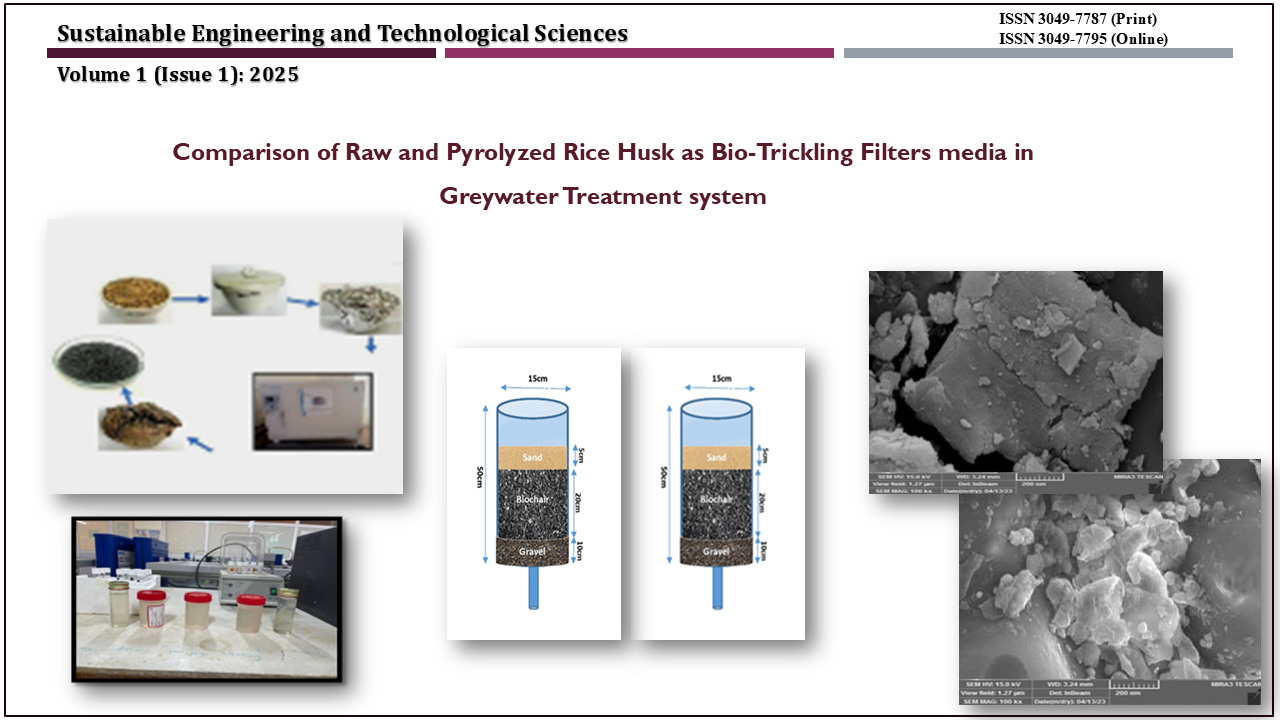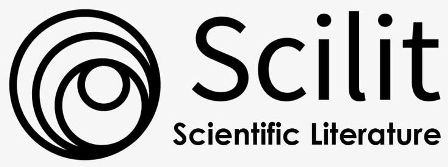Comparison of Raw and Pyrolyzed Rice Husk as Bio-Trickling Filters Media in Greywater Treatment System
DOI:
https://doi.org/10.70516/34yn7403Keywords:
Rice Husk, Biomass, Bio Char, Greywater, Waste, PorosityAbstract
Iraq currently faces an absence of water, worsened by population growth. As a result, if new water sources are not supplied, the country’s yearly per capita water supply will decrease. In this study, a simple, promising, and economical method for on-site greywater treatment is developed, employing agricultural waste as a bio filter medium and using it as irrigation water in rural Iraqi areas. The impact of rice husk biomass waste's pyrolysis and bio char characteristics on greywater treatment was examined using a bio trickling column treatment. Waste biomass from rice husks was paralyzed at 360°C. The pyrolysis of the husk biomass resulted in an increased surface area and pores. COD and BOD removal percentages in BTF2 were 81% and 88%, respectively. BTF1 has a 65% efficiency in COD removal and a 71% efficiency in BOD removal. For BTF1 and BTF2, the corresponding nitrate removal percentages were 52.93% and 75.38%. For BTF1 and BTF2, the respective phosphate removal rates were 45% and 65%. For BTF2, in this study the result show that the filter BTF2 (bio char filter) was the more effected than BTF1 (raw rice husk filter) in removal pollutant from greywater demonstrated a good deal of promise for treating greywater. Limiting the accumulation of agricultural waste and using it as a bio filter media for municipal greywater treatment are essential steps toward ensuring the environmentally safe disposal of agricultural waste in Iraq and reducing the cost of wastewater treatment.
Downloads
References
Alemu, Z.A. and M.O. Dioha, Modelling scenarios for sustainable water supply and demand in Addis Ababa city, Ethiopia. Environmental Systems Research, 2020. 9(1): p. 7. https://doi.org/10.1186/s40068-020-00168-3 DOI: https://doi.org/10.1186/s40068-020-00168-3
Edwin, G.A., P. Gopalsamy, and N. Muthu, Characterization of domestic gray water from point source to determine the potential for urban residential reuse: a short review. Applied Water Science, 2014. 4(1): p. 39-49. https://doi.org/10.1007/s13201-013-0128-8 DOI: https://doi.org/10.1007/s13201-013-0128-8
Filali, H., et al., Greywater as an Alternative Solution for a Sustainable Management of Water Resources—A Review. Sustainability, 2022. 14(2): p. 665. DOI: https://doi.org/10.3390/su14020665
Solihu, H. and S.O. Bilewu, Availability, coverage, and access to the potable water supply in Oyo State Nigeria. Environmental Challenges, 2021. 5: p. 100335. https://doi.org/10.1016/j.envc.2021.100335 DOI: https://doi.org/10.1016/j.envc.2021.100335
Andarge, N.A., Assessment of greywater treatment methods for reuse in Addis Ababa condominiums-a case of summit condominium. Addis Ababa Science and Technology University, 2019. 1(1): p. 1–128.
Boano, F., et al., A review of nature-based solutions for greywater treatment: Applications, hydraulic design, and environmental benefits. Science of The Total Environment, 2020. 711: p. 134731. https://doi.org/10.1016/j.scitotenv.2019.134731 DOI: https://doi.org/10.1016/j.scitotenv.2019.134731
Mandal, D., et al., Water conservation due to greywater treatment and reuse in urban setting with specific context to developing countries. Resources, Conservation and Recycling, 2011. 55(3): p. 356-361. https://doi.org/10.1016/j.resconrec.2010.11.001 DOI: https://doi.org/10.1016/j.resconrec.2010.11.001
Ghaitidak, D.M. and K.D. Yadav, Characteristics and treatment of greywater—a review. Environmental Science and Pollution Research, 2013. 20(5): p. 2795-2809. https://doi.org/10.1007/s11356-013-1533-0 DOI: https://doi.org/10.1007/s11356-013-1533-0
Jamrah, A., et al., Evaluating greywater reuse potential for sustainable water resources management in Oman. Environmental Monitoring and Assessment, 2008. 137(1): p. 315-327. https://doi.org/10.1007/s10661-007-9767-2 DOI: https://doi.org/10.1007/s10661-007-9767-2
Emmerson, G., Q.P.L. Publications, and R. Section, Every Drop is Precious: Greywater as an Alternative Water Source. 1998, Brisbane, Australia: Queensland Parliamentary Library Publications and Resources Section. 47.
Hussain, I., et al., Wastewater use in Agriculture: Review of Impacts and Methodological Issues in Valuing Impacts. 2002, Colombo, Sri Lanka: International Water Management Institute. 62.
Eriksson, E., et al., Characteristics of grey wastewater. Urban Water, 2002. 4(1): p. 85-104. https://doi.org/10.1016/S1462-0758(01)00064-4 DOI: https://doi.org/10.1016/S1462-0758(01)00064-4
Halalsheh, M., et al., Grey water characteristics and treatment options for rural areas in Jordan. Bioresource Technology, 2008. 99(14): p. 6635-6641. https://doi.org/10.1016/j.biortech.2007.12.029 DOI: https://doi.org/10.1016/j.biortech.2007.12.029
Dalahmeh, S.S., et al., Potential of organic filter materials for treating greywater to achieve irrigation quality: a review. Water Science and Technology, 2011. 63(9): p. 1832-1840. https://doi.org/10.2166/wst.2011.387 DOI: https://doi.org/10.2166/wst.2011.387
Nolde, E., Greywater reuse systems for toilet flushing in multi-storey buildings–over ten years experience in Berlin. Urban water, 2000. 1(4): p. 275-284. DOI: https://doi.org/10.1016/S1462-0758(00)00023-6
Ghunmi, L.A., et al., Grey Water Treatment Systems: A Review. Critical Reviews in Environmental Science and Technology, 2011. 41(7): p. 657-698. https://doi.org/10.1080/10643380903048443 DOI: https://doi.org/10.1080/10643380903048443
Holt, P. and E. James, Wastewater reuse in the Urban Environment: selection of technologies. 2006: Landcom.
Li, F., Treatment of household grey water for non-potable reuses. 2009: TUHH, Inst. of Water Resources and Water Supply.
Juhna, T. and E. Melin, Ozonation and biofiltration in water treatment, operational status and optimization issues. Techneau (WP5. 3 Operation of water treatment facilities–optimization efforts and modeling of unit processes), 2006.
Diaper, C., et al., Small scale water recycling systems - risk assessment and modelling. Water Science and Technology, 2001. 43(10): p. 83-90. https://doi.org/10.2166/wst.2001.0587 DOI: https://doi.org/10.2166/wst.2001.0587
Spychala, M. and R. Blazejewski, Sand filter clogging by septic tank effluent. Water Science and Technology, 2004. 48(11-12): p. 153-159. https://doi.org/10.2166/wst.2004.0828 DOI: https://doi.org/10.2166/wst.2004.0828
Roy, C., R. Auger, and R. Chénier, Use of non woven textile in intermittent filters. Water Science and Technology, 1998. 38(3): p. 159-166. https://doi.org/10.1016/S0273-1223(98)00460-0 DOI: https://doi.org/10.2166/wst.1998.0198
Lens, P.N., et al., Direct treatment of domestic wastewater by percolation over peat, bark and woodchips. Water Research, 1994. 28(1): p. 17-26. https://doi.org/10.1016/0043-1354(94)90115-5 DOI: https://doi.org/10.1016/0043-1354(94)90115-5
Babel, S. and T.A. Kurniawan, Cr(VI) removal from synthetic wastewater using coconut shell charcoal and commercial activated carbon modified with oxidizing agents and/or chitosan. Chemosphere, 2004. 54(7): p. 951-967. https://doi.org/10.1016/j.chemosphere.2003.10.001 DOI: https://doi.org/10.1016/j.chemosphere.2003.10.001
Mukherjee, S., et al., Removal of phenols from water environment by activated carbon, bagasse ash and wood charcoal. Chemical Engineering Journal, 2007. 129(1): p. 133-142. https://doi.org/10.1016/j.cej.2006.10.030 DOI: https://doi.org/10.1016/j.cej.2006.10.030
Parjane, S.B. and M.G. Sane, Performance of grey water treatment plant by economical way for Indian rural development. International Journal of ChemTech Research, 2011. 3(4): p. 1808-1815.
Abbas, E.K. and S.A.K. Ali, Assessment of Biological Trickling System with Different Layers of Material for Grey Water Treatment. IOP Conference Series: Earth and Environmental Science, 2023. 1232(1): p. 012018. https://doi.org/10.1088/1755-1315/1232/1/012018 DOI: https://doi.org/10.1088/1755-1315/1232/1/012018
De Gisi, S., et al., Grey water in buildings: a mini-review of guidelines, technologies and case studies. Civil Engineering and Environmental Systems, 2016. 33(1): p. 35-54. https://doi.org/10.1080/10286608.2015.1124868 DOI: https://doi.org/10.1080/10286608.2015.1124868
Carranzo, I.V. Standard Methods for examination of water and wastewater. in Anales de hidrología médica. 2012. Universidad Complutense de Madrid.
Tusiime, A., et al., Performance of lab-scale filtration system for grey water treatment and reuse. Environmental Challenges, 2022. 9: p. 100641. https://doi.org/10.1016/j.envc.2022.100641 DOI: https://doi.org/10.1016/j.envc.2022.100641
Dalahmeh, S.S., et al., Efficiency of Bark, Activated Charcoal, Foam and Sand Filters in Reducing Pollutants from Greywater. Water, Air, & Soil Pollution, 2012. 223(7): p. 3657-3671. https://doi.org/10.1007/s11270-012-1139-z DOI: https://doi.org/10.1007/s11270-012-1139-z
EPA, Waste water treatment manuals; preliminary treatment 1995.
Fatoki, O. and S. Mathabatha, An assessment of heavy metal pollution in the East London and Port Elizabeth harbours. Water Sa, 2001. 27(2): p. 233-240. https://doi.org/10.4314/wsa.v27i2.4997 DOI: https://doi.org/10.4314/wsa.v27i2.4997
Tomczyk, A., Z. Sokołowska, and P. Boguta, Biochar physicochemical properties: pyrolysis temperature and feedstock kind effects. Reviews in Environmental Science and Bio/Technology, 2020. 19(1): p. 191-215. https://doi.org/10.1007/s11157-020-09523-3 DOI: https://doi.org/10.1007/s11157-020-09523-3
Samaniego, J. and M.A.N. Tanchuling, Treatment of small scale gold mining wastewater using pilot-scale sedimentation and Cocopeat filter bed system. Global Journal of Environmental Science and Management, 2019. 5(4): p. 461-470. https://doi.org/10.22034/gjesm.2019.04.06
Suman, S. and S. Gautam, Pyrolysis of coconut husk biomass: Analysis of its biochar properties. Energy Sources, Part A: Recovery, Utilization, and Environmental Effects, 2017. 39(8): p. 761-767. https://doi.org/10.1080/15567036.2016.1263252 DOI: https://doi.org/10.1080/15567036.2016.1263252
Egbosiuba, T.C., et al., Ultrasonic enhanced adsorption of methylene blue onto the optimized surface area of activated carbon: Adsorption isotherm, kinetics and thermodynamics. Chemical Engineering Research and Design, 2020. 153: p. 315-336. https://doi.org/10.1016/j.cherd.2019.10.016 DOI: https://doi.org/10.1016/j.cherd.2019.10.016
Winward, G.P., et al., A study of the microbial quality of grey water and an evaluation of treatment technologies for reuse. Ecological Engineering, 2008. 32(2): p. 187-197. https://doi.org/10.1016/j.ecoleng.2007.11.001 DOI: https://doi.org/10.1016/j.ecoleng.2007.11.001
Nguyen, B.T. and J. Lehmann, Black carbon decomposition under varying water regimes. Organic Geochemistry, 2009. 40(8): p. 846-853. https://doi.org/10.1016/j.orggeochem.2009.05.004 DOI: https://doi.org/10.1016/j.orggeochem.2009.05.004
Kawamura, S., Integrated design and operation of water treatment facilities. 2000, NY, USA: John Wiley & Sons. 720.
Joniec, J. and J. Furczak, Biochemical characterization of podzolic soil under willow culture after three years from its amendment with sewage sludge. Polish Journal of Soil Science, 2007. 2(40): p. 207-215.
Belhachemi, M., et al., 3 - Characterization of biomass-derived chars, in Char and Carbon Materials Derived from Biomass, M. Jeguirim and L. Limousy, Editors. 2019, Elsevier: Mulhouse, France. p. 69-108. https://doi.org/10.1016/B978-0-12-814893-8.00003-1 DOI: https://doi.org/10.1016/B978-0-12-814893-8.00003-1
Dalahmeh, S., Bark and charcoal filters for greywater treatment: Pollutant Removal and Recycling Opportunities. Ph.D., Department of Energy and Technology Swedish University of Agricultural Sciences, Uppsala.
Qambrani, N.A., et al., Biochar properties and eco-friendly applications for climate change mitigation, waste management, and wastewater treatment: A review. Renewable and Sustainable Energy Reviews, 2017. 79: p. 255-273. https://doi.org/10.1016/j.rser.2017.05.057 DOI: https://doi.org/10.1016/j.rser.2017.05.057
Halfhide, T., et al., Nutrient removal using spent coconut husks. h2oj, 2019. 2(1): p. 125-136. https://doi.org/10.2166/h2oj.2019.011 DOI: https://doi.org/10.2166/h2oj.2019.011
Maurya, S.P., et al., Identification of indicators for sustainable urban water development planning. Ecological Indicators, 2020. 108: p. 105691. https://doi.org/10.1016/j.ecolind.2019.105691 DOI: https://doi.org/10.1016/j.ecolind.2019.105691
Afrooz, A.R.M.N. and A.B. Boehm, Escherichia coli Removal in Biochar-Modified Biofilters: Effects of Biofilm. PLOS ONE, 2016. 11(12): p. e0167489. https://doi.org/10.1371/journal.pone.0167489 DOI: https://doi.org/10.1371/journal.pone.0167489
Niwagaba, C.B., et al., Experiences on the implementation of a pilot grey water treatment and reuse based system at a household in the slum of Kyebando-Kisalosalo, Kampala. Journal of Water Reuse and Desalination, 2014. 4(4): p. 294-307. https://doi.org/10.2166/wrd.2014.016 DOI: https://doi.org/10.2166/wrd.2014.016
Katukiza, A.Y., et al., Grey water treatment in urban slums by a filtration system: Optimisation of the filtration medium. Journal of Environmental Management, 2014. 146: p. 131-141. https://doi.org/10.1016/j.jenvman.2014.07.033 DOI: https://doi.org/10.1016/j.jenvman.2014.07.033
Khan, Z.U., et al., Performance efficiency of an integrated stone media fixed biofilm reactor and sand filter for sewage treatment. Desalination and Water Treatment, 2015. 54(10): p. 2638-2647. https://doi.org/10.1080/19443994.2014.903521 DOI: https://doi.org/10.1080/19443994.2014.903521

Downloads
Published
Issue
Section
Categories
License
Copyright (c) 2024 Ebtesam K. Abbas, Seroor Atalah K. Ali (Author)

This work is licensed under a Creative Commons Attribution-NonCommercial-NoDerivatives 4.0 International License.
Open Access and Copyright: SETS operates as an open-access journal, making all its articles freely available to everyone. Published content is licensed under the Creative Commons Attribution International Public License (CC BY 4.0). This license allows individuals and organizations to:
- Download, share, distribute, and print full texts of articles
- Reproduce or link to articles in any medium,
While authors retain copyright for their published work on the SETS website, the journal actively promotes and tracks citations to increase recognition for their research.
In essence, CC-BY-4.0 encourages the widest possible dissemination and utilization of published articles as long as written permission and appropriate credit are given to the authors.







